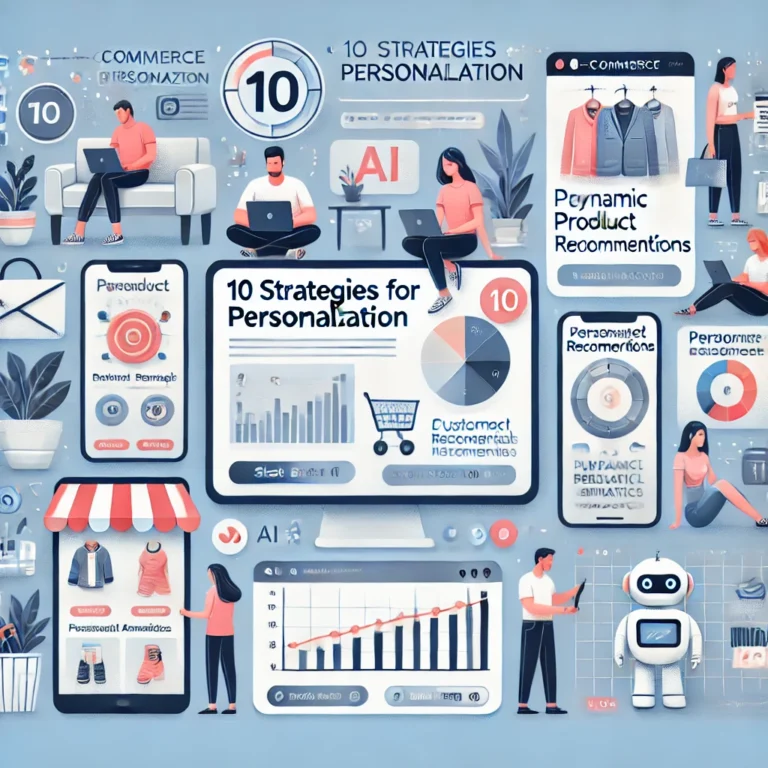In today’s competitive ecommerce landscape, standing out from the crowd is essential. Customers crave a shopping experience that feels as unique as they are themselves. This is where trends in ecommerce personalisation come into play. By leveraging data and innovative technologies, businesses can craft personalised journeys that resonate deeply with each customer, ultimately driving sales and building lasting brand loyalty. This comprehensive guide explores the latest trends shaping personalisation in ecommerce, equipping you with the strategies and tactics to transform your online store into a personalisation powerhouse.
The landscape of ecommerce is constantly evolving, and customer expectations are no exception. Today’s online shoppers crave a shopping experience as unique and individual as they are themselves. This is where personalisation steps in, not just as a passing fad, but as the cornerstone of future ecommerce success. This guide equips you, the ecommerce professional, with the trends, tactics, and winning strategies to transform your store into a personalisation powerhouse. Let’s delve into the exciting world of ecommerce personalisation in 2024!
Unlocking the Power of Personalisation
Personalisation goes beyond merely slapping a customer’s name on an email. It’s about understanding their behaviour, preferences, and purchase history to craft a shopping journey that feels designed just for them. Why is this crucial? Here’s the magic:
- Boosted Sales and Conversions: Personalised experiences resonate with customers, leading to a higher chance of them buying (think targeted product recommendations!). Studies by McKinsey & Company show that personalisation most often drives 10 to 15 percent revenue lift.
- Enhanced Customer Experience: Imagine a store that remembers your favourite brands and suggests similar styles. Personalisation fosters a sense of connection and makes shopping enjoyable, keeping customers coming back for more.
The Future of Personalisation in Ecommerce
The future trends in ecommerce personalisation are brimming with innovation. Here’s a glimpse of what’s on the horizon:
- Hyper-Personalisation: This takes personalisation to the next level, tailoring experiences to individual customer micro-moments. Imagine product recommendations that adjust based on the weather or time of day!
- AI’s Growing Influence: Artificial intelligence (AI) is already a game-changer, analysing vast amounts of data to predict customer behaviour and deliver hyper-personalised experiences. AI is already asking questions in all aspects of our industry. In a separate article, we’re asking will ai replace web developers?
Maximising Sales Through Personalisation
Now let’s get down to business and leverage these trends in ecommerce personalisation! Here are powerful strategies to exploit personalisation and skyrocket your sales:
- Craft Personalised Product Recommendations: Use customer data to suggest products they’ll genuinely love. This could be based on past purchases, browsing behaviour, or even items they’ve viewed but not added to their basket.
- Segment Your Audience: Don’t treat all customers the same. Group them based on demographics, interests, or purchase history. This allows you to tailor your messaging and product recommendations for maximum impact.
Exploring Personalisation Metrics for Ecommerce Success
Understanding the effectiveness of your personalization efforts is crucial. Here’s where key metrics come into play:
- Conversion Rates: This measures the percentage of visitors who complete a desired action, like making a purchase. Increased conversion rates indicate successful personalisation.
- Average Order Value (AOV): This metric reveals the average amount spent per order. Personalisation can encourage customers to spend more by recommending complementary products.
- Customer Lifetime Value (CLTV): This metric calculates the total revenue a customer is expected to generate throughout their relationship with your brand. Personalised experiences can foster loyalty and increase CLTV.
Implementing Dynamic Pricing Strategies for Personalised Shopping Experiences
Dynamic pricing allows you to adjust prices based on factors like customer behaviour and market demand. Here’s how it plays into personalisation:
- Personalised Offers and Discounts: Offer customers personalised discounts or special deals based on their purchase history and engagement levels.
- Optimising Prices Based on Customer Segments: Segment your audience and adjust prices according to their perceived value of your products.
Utilising User-Generated Content to Enhance Personalisation
User-generated content (UGC), like reviews and social media posts, can be a powerful tool for personalisation:
- Social Proof: Showcase positive UGC next to relevant products to build trust and influence purchasing decisions.
- Personalised Product Recommendations Based on UGC: Analyse customer reviews and social media engagement to recommend products that resonate with specific customer segments.
Innovative Approaches to Personalised Product Recommendations
Delivering personalised product recommendations goes beyond basic algorithms. Let’s explore cutting-edge techniques:
- AI-Powered Recommendations: Use AI algorithms to analyse vast amounts of customer data and predict their needs with exceptional accuracy.
- Machine Learning for Dynamic Recommendations: Leverage machine learning to personalise recommendations in real-time based on a customer’s current browsing behaviour and search queries.
Optimising Personalised Email Marketing Campaigns
Email marketing remains a powerful tool in ecommerce. Personalisation unlocks its full potential:
- Segment Your Email List: Divide your email list into groups based on demographics, interests, and purchase history for targeted campaigns.
- Personalised Content and Offers: Craft email content tailored to each segment, including personalised product recommendations and special offers relevant to their preferences.
- A/B Testing: Test different email subject lines, content, and offers to optimise results and ensure your personalisation efforts resonate with your audience.
Exploring the Role of Personalisation in Cross-Selling and Upselling
Personalization is key to effectively cross-selling and upselling products, encouraging customers to purchase additional items:
- Recommend Complementary Products: Based on past purchases, suggest products that complement their previous choices. For example, recommend a phone case after someone buys a new phone.
- Upselling Based on Browsing Behaviour: If a customer is looking at high-end headphones, suggest premium audio cables as an upsell opportunity.
- Personalised Bundles: Create product bundles tailored to specific customer segments, combining popular items or offering discounts on bundled purchases.
Enhancing Personalisation Through Omnichannel Integration
A seamless shopping experience across all channels is crucial. Here’s how omnichannel integration enhances personalisation:
- Unified Customer Data Platform: Implement a central platform that collects and consolidates customer data from all touchpoints (website, mobile app, physical stores).
- Personalised Experiences Across Channels: Leverage this data to deliver personalised recommendations, loyalty programs, and marketing messages across all channels, ensuring consistency and a unified customer journey.
Addressing Privacy Concerns in Personalised Marketing
Building trust is paramount. Here’s how to navigate privacy concerns in personalized marketing:
- Transparency is Key: Be transparent about how you collect and use customer data. Clearly outline your data privacy policy and offer customers control over their data.
- Comply with Data Privacy Regulations: Ensure your practices adhere to data privacy regulations like GDPR and CCPA.
- Focus on Value: Personalisation should enhance the customer experience, not feel intrusive. Focus on delivering relevant recommendations and offers that benefit your customers.
Customising Product Pages for Personalised Shopping Journeys
Product pages are prime real estate for personalisation:
- Dynamic Product Descriptions: Tailor product descriptions based on user demographics or browsing behaviour. Highlight different features depending on what interests the customer.
- Personalised Product Images and Videos: Showcase product images and videos that resonate with the customer’s preferences. This could involve showcasing specific colours or styles based on past purchases.
- Dynamic Search Results Within Product Pages: Utilise search functionality within product pages and personalise results based on the customer’s current browsing journey and product they’re viewing.
Using Social Media for Personalised Customer Engagement
Social media platforms offer valuable opportunities for personalised customer engagement:
- Social Listening: Use social listening tools to understand customer sentiment, preferences, and brand perception on social media.
- Targeted Social Media Ads: Leverage customer data to create targeted social media ad campaigns featuring personalised product recommendations and offers.
- Personalised Customer Support on Social Media: Respond to customer inquiries and questions on social media in a personalised manner, referencing their purchase history or past interactions.
Frequently Asked Questions About Trends in Ecommerce Personalisation
Why do customers want personalisation?
Convenience: Personalisation saves time and effort by suggesting relevant products instead of customers needing to browse through a vast selection.
Relevance: Personalised recommendations feel more relevant to their needs and interests, leading to a more enjoyable shopping experience.
Sense of Value: Personalised experiences can make customers feel valued and understood, fostering trust and loyalty towards the brand.
Conclusion
Personalisation is no longer a fad; it’s the future of ecommerce. By understanding customer behaviour, leveraging data effectively, and implementing the strategies outlined in this guide, you can transform your ecommerce store into a personalisation powerhouse. Create a seamless and engaging shopping experience for your customers, foster long-term relationships, and watch your sales and customer loyalty soar.





